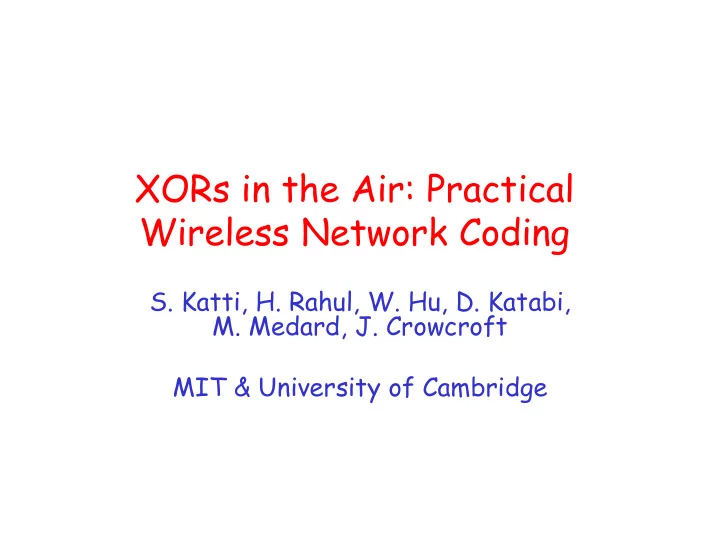

XORs in the Air: Practical Wireless Network Coding S. Katti, H. Rahul, W. Hu, D. Katabi, M. Medard, J. Crowcroft MIT & University of Cambridge
Can we use 3 transmissions to send traffic? 2 1 3 4
Can we use 3 transmissions to send traffic? 1+3 1 3
Network Coding • Three types – Store and forward – Source coding (FEC, compression) – Network coding • Goal: increase the amount of information that is transported
Network Coding in Wireline Networks b S a b a b a D1 D2 Networking coding is beneficial for multicast in wireline networks. Networking coding has little benefit for unicast in wireline networks.
Coding Gain • Coding gain = 4/3 1+3 1 3
Coding Gain: more examples S2 S1 D1 D2 Without opportunistic listening, no coding gain.
Coding Gain: more examples 2 1 1+2 With opportunistic listening, coding gain = 4/3.
Throughput Improvement • UDP throughput improvement ~ a factor 2 > 4/3 coding gain 1+3 1 3
Coding Gain: more examples 2 5 1 3 4 1+2+3+4+5 With opportunistic listening, coding gain=2N/(1+N) 2. With opportunistic listening, coding gain + MAC gain ∞
Properties • In the absence of opportunistic listening, COPE’s maximum coding gain is 2 and it is achievable. • In the absence of opportunistic listening, COPE’s maximum coding gain + MAC gain is 2 and it is achievable. • In the presence of opportunistic listening, COPE’s maximum coding+MAC gain is unbounded. • Can we achieve unbounded MAC gain without using network coding?
COPE Overview • Layer between IP and MAC • Techniques – Opportunistic listening (promiscuous mode) – Opportunistic coding – Learning neighbor state
Opportunistic Coding B’s queue Next hop P4 P1 P1 A P2 C C P3 C P4 P3 P2 P1 P4 D B Coding Is it good? P1+P2 Bad (only C can decode) D A P1+P3 Better coding (Both A and C can decode) P3 P1 P1+P3+P4 Best coding (A, C, D P4 P3 can decode)
Packet Coding Algorithm • When to send? – Option 1: delay packets till enough packets to code with – Option 2: never delaying packets -- when there’s a transmission opportunity, send packet right away • Which packets to use for XOR? – Prefer XOR-ing packets of similar lengths – Never code together packets headed to the same next hop – Limit packet re-ordering – XORing a packet as long as all its nexthops can decode it with a high enough probability
Packet Decoding • Where to decode? – Decode at each intermediate hop • How to decode? – Upon receiving a packet encoded with n native packets • find n-1 native packets from its queue • XOR these n-1 native packets with the received packet to extract the new packet
Use unicast or broadcast transmissions?
Pseudo Broadcast • Each packet is destined for multiple nexthops – Broadcast • Natural for multiple receivers – Unicast • Cheap ACK wo/ contention • Link layer retransmissions • More effective backoff • Take advantage of multiple rates – Unicast + hop-by-hop ACKs/retx • Unicast alone is insufficient. Why?
Prevent Packet Reordering • Packet reordering due to async acks degrade TCP performance • Ordering agent – Deliver in-sequence packets immediately – Order the packets until the gap in seq. no is filled or timer expires
Summary of Results • Improve UDP throughput by a factor of 3- 4 • Improve TCP by – wo/ hidden terminal: up to 38% improvement – w/ hidden terminal and high loss: little improvement • Improvement is largest when uplink to downlink has similar traffic
Reasons for Lower Improvement in TCP • COPE introduces packet re-ordering • Router queue is small smaller coding opportunity – TCP congestion window does not sufficiently open up due to wireless losses • TCP doesn’t provide fair allocation across different flows
Comments about COPE?
Comments • Not all traffic and topologies can benefit from inter-flow coding • Tradeoff between coding gain and spatial reuse • Coding in WLAN?
Comments • Interactions with rate adaptation • Coding-aware routing • Coding-aware rate limit • Coding-aware topology control • Coding in WLAN?
Lessons • Wireless link lossy wireline lines – Both COPE and opportunistic routing discard the point-to-point wireless link abstraction – Leverage broadcast nature of wireless medium to its advantage • Network coding has a great potential in wireless network
Network Coding • Intra flow coding • Inter flow coding
Recommend
More recommend